SimFire uses PyGame to display and simulate different fire spread models, including the Rothermel Surface fire spread model described in this paper.
For more comprehensive documentation, go to our docs page.


Left: Fire simulated near Julian, CA. Right: Fire simulated near Reno, NV.
Both fires have winds from the east at 20mph
Install simfire by following the installation instructions. Then run the run_game.py script:
python run_game.pyfrom simfire.sim.simulation import FireSimulation
from simfire.utils.config import Config
config = Config("configs/operational_config.yml")
sim = FireSimulation(config)
# Run a 1 hour simulation
sim.run("1h")
# Run the same simulation for 30 more minutes
sim.run("30m")
# Render the next 2 hours of simulation
sim.rendering = True
sim.run("2h")
# Now save a GIF and fire spread graph from the last 2 hours of simulation
sim.save_gif()
sim.save_spread_graph()
# Saved to the location specified in the config: simulation.sf_home
# Update agents for display
# (x, y, agent_id)
agent_0 = (5, 5, 0)
agent_1 = (5, 5, 1)
agents = [agent_0, agent_1]
# Create the agents on the display
sim.update_agent_positions(agents)
# Loop through to move agents
for i in range(5):
agent_0 = (5 + i, 5 + i, 0)
agent_1 = (5 + i, 5 + i, 1)
# Update the agent positions on the simulation
sim.update_agent_positions([agent_0, agent_1])
# Run for 1 update step
sim.run(1)
# Turn off rendering so the display disappears and the simulation continues to run in the
# background
sim.rendering = Falsepip install simfireFor contributing, see the Contribution Page in our docs.
To cite this software, use the “Cite this repository” link built into GitHub on the right.
Copyright ©2023 The MITRE Corporation. ALL RIGHTS RESERVED. Approved for Public Release; Distribution Unlimited. Public Release Case Number 22-3261.